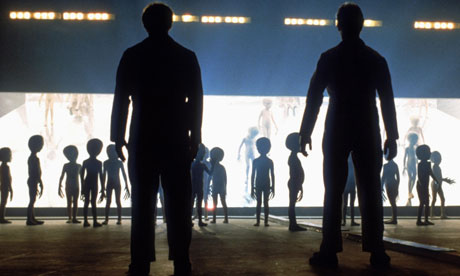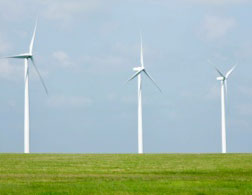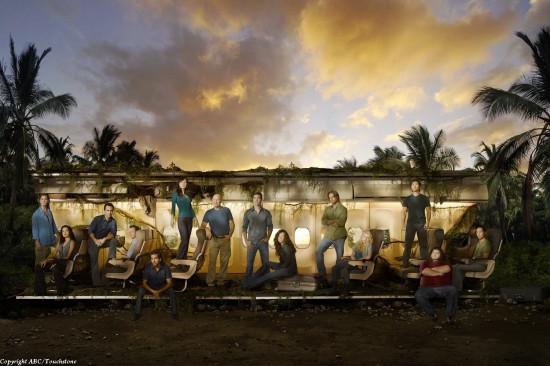
Close enough? A scene from Close Encounters of the Third Kind. Photograph: Allstar/COLUMBIA/Sportsphoto Ltd./Allstar
In February 2008, Nasa sent the Beatles song, Across the Universe, across the universe. Pointing the telescopes in its Deep
Space Network towards the north star, Polaris, astronomers played out their short cosmic DJ set, hoping that it might be heard by intelligent aliens during its 430-year journey to the star.
The hunt for intelligent species outside Earth may be a staple of literature and film – but it is happening in real life, too. Nasa probes are on the lookout for planets outside our solar system, and astronomers are carefully listening for any messages being beamed through space. How awe-inspiring it would be to get confirmation that we are not alone in the universe, to finally speak to an alien race. Wouldn't it?
Well no,
according to the eminent physicist Stephen Hawking. "If aliens visit us, the outcome would be much as when Columbus landed in America, which didn't turn out well for the Native Americans," Hawking has said in a forthcoming documentary made for the Discovery Channel. He argues that, instead of trying to find and communicate with life in the cosmos, humans would be better
off doing everything they can to
avoid contact.
Hawking believes that, based on the sheer number of planets that scientists know must exist, we are not the only life-form in the universe. There are, after all, billions and billions of stars in our galaxy alone,
with, it is reasonable to expect, an even greater number of planets orbiting them. And it is not unreasonable to expect some of that
alien life to be intelligent, and capable of interstellar communication. So, when someone with Hawking's knowledge of the universe advises against contact, it's worth listening, isn't it?
Seth Shostak, a senior astronomer at the Seti Institute in California, the world's leading organisation searching for telltale alien signals, is not so sure. "This is an unwarranted fear," Shostak says. "If their interest in our planet is for something valuable that our planet has to offer, there's no particular reason to worry about them now. If they're interested in resources, they have ways of finding rocky planets that don't depend on whether we broadcast or not. They could have found us a billion years ago."
If we were really worried about shouting in the stellar jungle, Shostak says, the first thing to do would be to shut down the BBC, NBC, CBS and the radars at all airports. Those broadcasts have been streaming into space for years – the oldest is already more than 80 light years from Earth – so it is already too late to stop passing aliens watching every episode of Big Brother or What Katie and Peter Did Next.
The biggest and most active hunt for life outside Earth started in 1960, when Frank Drake pointed the Green Bank radio telescope in West Virginia towards the star Tau Ceti. He was looking for anomalous radio signals that could have been sent by intelligent life. Eventually, his idea turned into Seti (standing for Search for Extra Terrestrial Intelligence), which used the downtime on radar telescopes around the world to scour the sky for any signals. For 50 years, however, the sky has been silent.
There are lots of practical problems involved in hunting for aliens, of course, chief among them being distance. If our nearest neighbours were life-forms on the (fictional) forest moon of Endor, 1,000 light years away, it would take a millennium for us to receive any message they might send. If the Endorians were watching us, the light reaching them from Earth at this very moment would show them our planet as it was 1,000 years ago; in Europe that means lots of fighting between knights around castles and, in north America, small bands of natives living on the great plains. It is not a timescale that allows for quick banter – and, anyway, they might not be communicating in our direction.
The lack of a signal from ET has not, however, prevented astronomers and biologists (not to mention film-makers) coming up with a whole range of ideas about what aliens might be like. In the early days of Seti, astronomers focused on the search for planets like ours – the idea being that, since the only biology we know about is our own, we might as well assume aliens are going to be something like us. But there's no reason why that should be true. You don't even need to step off the Earth to find life that is radically different from our common experience of it.
"Extremophiles" are species that can survive in places that would quickly kill humans and other "normal" life-forms. These single-celled creatures have been found in boiling hot vents of water thrusting through the ocean floor, or at temperatures well below the freezing point of water. The front ends of some creatures that live near deep-sea vents are 200C warmer than their back ends.
"In our naive and parochial way, we have named these things extremophiles, which shows prejudice – we're normal, everything else is extreme," says Ian Stewart, a mathematician at Warwick University and author of What Does A Martian Look Like? "From the point of view of a creature that lives in boiling water, we're extreme because we live in much milder temperatures. We're at least as extreme compared to them as they are compared to us."
On Earth, life exists in water and on land but, on a giant gas planet, for example, it might exist high in the atmosphere, trapping nutrients from the air swirling around it. And given that aliens may be so out of our experience, guessing motives and intentions if they ever got in touch seems beyond the realm's even of Hawking's mind.
Paul Davies, an astrophysicist at Arizona State University and chair of Seti's post-detection taskforce, argues that alien brains, with their different architecture, would interpret information very differently from ours. What we think of as beautiful or friendly might come across as violent to them, or vice versa. "Lots of people think that because they would be so wise and knowledgeable, they would be peaceful," adds Stewart. "I don't think you can assume that. I don't think you can put human views on to them; that's a dangerous way of thinking. Aliens are alien. If they exist at all, we cannot assume they're like us."
Answers to some of these conundrums will begin to emerge in the next few decades. The researchers at the forefront of the work are astrobiologists, working in an area that has steadily marched in from the fringes of science thanks to the improvements in technology available to explore space.
Scientists discovered the first few extrasolar planets in the early 1990s and, ever since, the numbers have shot up. Today, scientists know of 443 planets orbiting around more than 350 stars. Most are gas giants in the mould of Jupiter, the smallest being Gliese 581, which has a mass of 1.9 Earths. In 2009, Nasa launched the Kepler satellite, a probe specifically designed to look for Earth-like planets.
Future generations of ground-based telescopes, such as the proposed European Extremely Large Telescope (with a 30m main mirror), could be operational by 2030, and would be powerful enough to image the atmospheres of faraway planets, looking for chemical signatures that could indicate life. The Seti Institute also, finally, has a serious piece of kit under construction: the Allen Array (funded by a $11.5m/£7.5m donation from Microsoft co-founder Paul Allen) has, at present, 42 radio antennae, each six metres in diameter, but there are plans, if the Seti Institute can raise another $35m, to have up to 300 radio dishes.
In all the years that Seti has been running, it has managed to look carefully at less than 1,000 star systems. With the full Allen Array, they could look at 1,000 star systems in a couple of years.
Shostak is confident that, as telescope technology keeps improving, Seti will find an ET signal within the next two decades. "We will have looked at another million star systems in two dozen years. If this is going to work, it will work soon."
And what happens if and when we detect a signal? "My strenuous advice will be that the coordinates of the transmitting entity should be kept confidential, until the world community has had a chance to evaluate what it's dealing with," Davies told the Guardian recently. "We don't want anybody just turning a radio telescope on the sky and sending their own messages to the source."
But his colleague, Shostak, says we should have no such concerns. "You'll have told the astronomical community – that's thousands of people. Are you going to ask them all not to tell anybody where you're pointing your antenna? There's no way you could do that.
"And anyway, why wouldn't you tell them where [the alien lifeform] is? Are you afraid people will broadcast their own message? They might do that but, remember, The Gong Show has already been broadcast for years." And, for that matter, the Beatles.




























 The
The 




